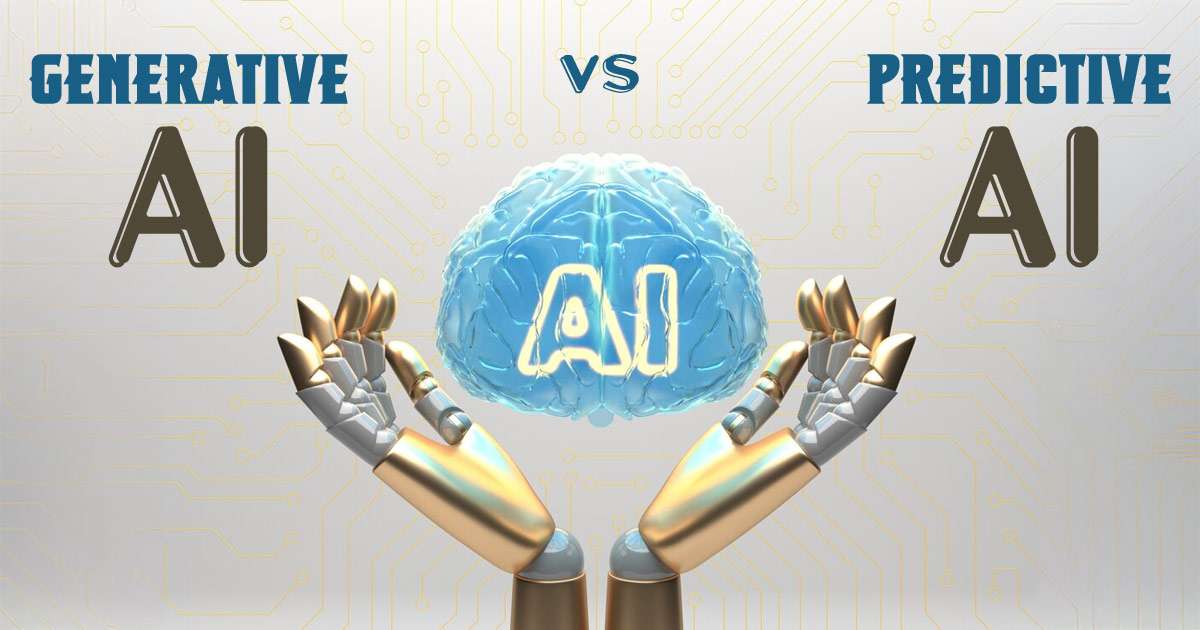Generative AI vs. Predictive AI: A Comparison of Capabilities

Artificial intelligence (AI) is advancing quickly, and two popular types—generative AI and predictive AI—are leading the way. Though both are powerful, they serve different roles and are used differently. To help you clarify their uses and how they differ, you need to know the difference between generative AI and predictive AI.
Gain Insights About Generative AI b& Predictive AI
Generative AI creates new content, such as text, images, and even music. It doesn’t just predict what comes next but actually generates fresh material based on the patterns it’s learned from the data it’s trained on.
Some examples of generative AI are:
- Text generators like ChatGPT, which produce human-like text responses.
- Image creators like DALL-E, which generate images based on descriptions.
- Music and art tools that create original music or artwork.
On the other hand, predictive artificial intelligence focuses on predicting outcomes or future events by analyzing past data. Instead of creating new content, it forecasts what might happen, making it valuable in areas like finance, healthcare, and marketing.
Examples of predictive AI include:
- Financial forecasting to predict stock prices.
- Weather prediction models that estimate future weather patterns.
- Customer behavior prediction in marketing to suggest what a person might buy next.
Difference between Generative AI and Predictive AI
Understanding the difference between generative AI and predictive AI is crucial for organizations looking to make the most of these technologies. Here are some important distinctions:
Purpose
Generative AI is made to create new content, like images, text, or music, by learning from patterns in existing data. It’s useful for generating completely original material in different formats.
Predictive AI focuses on forecasting future events by looking at past data. It’s commonly used to help make predictions that guide decision-making in areas like finance and healthcare.
Uses
Generative A is great for creating new and unique content. It’s used in tools that help with writing, making images, and composing music, helping creators and businesses produce high-quality content faster.
Predictive AI is used wherever forecasts are important, like in finance and weather prediction. It helps people understand trends and make decisions based on what might happen next.
Key Models
Generative AI uses models like GANs (Generative Adversarial Networks) and transformers. GANs work by having two networks—one that creates content and one that checks if it’s realistic—so the content improves over time.
Predictive AI often uses models like regression and time-series analysis. These tools look at past data to find patterns and make predictions, helping people prepare for the future.
Data Needs
Generative AI needs large amounts of varied data to create useful content. The more examples it has, the better it can learn patterns and produce realistic outputs.
Predictive AI needs past data to make accurate forecasts. The more historical data it has, the better its predictions will be, which is why it’s valuable in industries with lots of data.
Uses of Gen AI and Predictive AI
Where Generative AI is Used
Generative AI is especially popular in creative fields and data-heavy industries:
- Automatically create written content, images, and social media posts, making it valuable for marketing.
- It’s used to create synthetic data for research, which speeds up drug discovery.
- Helps design characters, worlds, and storylines for more immersive gaming experiences.
- Tools powered by generative AI enable artists and musicians to produce original works based on different styles.
Where Predictive AI is Used
Predictive AI is helpful for industries that rely on accurate forecasts and data-driven decisions:
- Help forecast patient outcomes and suggest personalized treatments.
- Used to estimate stock performance, helping investors make informed decisions.
- Suggest products that customers may want, improving customer targeting.
- Help predict equipment failures, making maintenance more efficient.
Synergy Between Generative and Predictive AI
Generative AI, with its focus on creating new content and generating innovative ideas, and predictive AI, centered on analyzing data and forecasting trends, can work together in powerful ways:
Better Decision-Making
When used together, generative models can create customized ideas or products, while predictive AI can forecast trends, helping businesses plan and innovate more effectively.
Enhanced Data
Generative AI can produce realistic data that strengthens predictive AI’s training datasets, improving its accuracy.
Creative Solutions
Generative AI can help brainstorm new solutions, while predictive AI assesses how realistic or feasible those ideas might be.
Challenges of Each Technology
Generative AI Challenges:
- Ensuring that generated content meets quality standards can be tricky, as outputs may sometimes lack accuracy or relevance.
- Potential to create misleading content, like deepfakes, which brings up ethical concerns about misuse and accountability.
Predictive AI Challenges:
- Heavily relies on past data. If the data is biased or incomplete, predictions may be inaccurate.
- Predicting human behavior is tough since people’s actions can be unpredictable and influenced by many factors.
Future Trends in Generative vs. Predictive AI
As AI continues to improve, the future of gen AI and predictive AI will likely see increased overlap. Here’s a look at what to expect:
Blending Capabilities
Combining the strengths of both generative and predictive AI will lead to advanced applications across various fields.
Algorithm Improvements
Research will continue to improve the performance of both types of AI, making them more accessible and effective for smaller organizations.
Developing Ethical Standards
As these technologies grow, establishing ethical guidelines will be key to ensuring they’re used responsibly across industries.
Harnessing Generative and Predictive AI for Success
Understanding the difference between generative AI and predictive AI helps maximize their unique strengths. Generative AI is ideal for creating original content, while predictive AI uses past data to forecast future trends, aiding business decisions. Each type benefits different industries, and together, they boost both creativity and efficiency.
By combining these technologies, organizations can better navigate the evolving AI landscape, encouraging innovation, informed decisions, and success in a competitive market.

